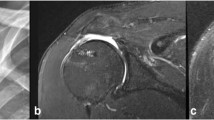Abstract
Purpose
The factors affecting the anatomical and functional outcomes of arthroscopic superior capsular reconstruction (ASCR) were investigated in this study. Continuity between the posterior remnant tissue and graft, as well as medial-to-lateral anatomical graft continuity, might play a vital role in shoulder stability and functional recovery, which could be correlated with postoperative factors such as the acromiohumeral distance (AHD).
Methods
Thirty-two patients (36 shoulders) who underwent ASCR were included. The follow-up period was 24.8 ± 6.9 months. The relationship between graft continuity and preoperative, intraoperative, and postoperative factors that could affect the clinical and radiological outcomes of ASCR were investigated.
Results
The American Shoulder and Elbow Surgeons score increased from 50.3 ± 9.1 points preoperatively to 84.0 ± 5.0 points postoperatively (p < 0.01), and the Constant score increased from 56.3 ± 9.0 to 82.8 ± 5.6 points (p = 0.02). Re-tearing occurred in 13 patients during the postoperative follow-up period. The re-tear rate was relatively high (36.1%). The gap between the immediate postoperative and preoperative AHDs was 1.6 ± 2.2 mm in the re-tear (+) group and 3.8 ± 2.8 mm in the re-tear (−) group (p = 0.02). The integrity of the posterior remnant tissue had a statistically significant and different re-tear rate (p < 0.01).
Conclusion
Care should be taken in patients with inadequate AHD improvement and poor posterior remnant tissue immediately postoperatively, because the possibility of re-tearing is high. Therefore, better results can be predicted when considering these factors at the time of surgery.
Level of evidence
IV.



Similar content being viewed by others
References
Chung SW, Kim JY, Kim MH, Kim SH, Oh JH (2013) Arthroscopic repair of massive rotator cuff tears: outcome and analysis of factors associated with healing failure or poor postoperative function. Am J Sports Med 41(7):1674–1683
Dell RB, Holleran S, Ramakrishnan R (2002) Sample size determination. ILAR J 43(4):207–213
Denard PJ, Brady PC, Adams CR, Tokish JM, Burkhart SS (2018) Preliminary results of arthroscopic superior capsule reconstruction with dermal allograft. Arthroscopy 34(1):93–99
Deranlot J, Herisson O, Nourissat G et al (2017) Arthroscopic subacromial spacer implantation in patients with massive irreparable rotator cuff tears: clinical and radiographic results of 39 retrospectives cases. Arthroscopy 33(9):1639–1644
Gerber C, Wirth SH, Farshad M (2011) Treatment options for massive rotator cuff tears. J Shoulder Elbow Surg 20(2):S20-S29
Mihata T, Lee TQ, Watanabe C et al (2013) Clinical results of arthroscopic superior capsule reconstruction for irreparable rotator cuff tears. Arthroscopy 29(3):459–470
Mihata T, McGarry MH, Kahn T, Goldberg I, Neo M, Lee TQ (2016) Biomechanical effect of thickness and tension of fascia lata graft on glenohumeral stability for superior capsule reconstruction in irreparable supraspinatus tears. Arthroscopy 32(3):418–426
Mihata T, McGarry MH, Kahn T, Goldberg I, Neo M, Lee TQ (2016) Biomechanical role of capsular continuity in superior capsule reconstruction for irreparable tears of the supraspinatus tendon. Am J Sports Med 44(6):1423–1430
Mihata T, McGarry MH, Pirolo JM, Kinoshita M, Lee TQ (2012) Superior capsule reconstruction to restore superior stability in irreparable rotator cuff tears: a biomechanical cadaveric study. Am J Sports Med 40(10):2248–2255
Nové-Josserand L, Edwards TB, O’Connor DP, Walch G (2005) The acromiohumeral and coracohumeral intervals are abnormal in rotator cuff tears with muscular fatty degeneration. Clin Orthop Relat Res 433:90–96
Park J, Chung SW, Lee S et al (2016) Combined subscapularis tears in massive posterosuperior rotator cuff tears: do they affect postoperative shoulder function and rotator cuff integrity? Am J Sports Med 44(1):183–190
Park JG, Cho NS, Song JH, Baek JH, Rhee YG (2016) Long-term outcome of tuberoplasty for irreparable massive rotator cuff tears: is tuberoplasty really applicable? J Shoulder Elbow Surg 25(2):224–231
Pennington WT, Bartz BA, Pauli JM, Walker CE, Schmidt W (2018) Arthroscopic superior capsular reconstruction with acellular dermal allograft for the treatment of massive irreparable rotator cuff tears: short-term clinical outcomes and the radiographic parameter of superior capsular distance. Arthroscopy. https://doi.org/10.1016/j.artho.2018.01.009
Funding
The authors received no financial support for the research, authorship, and/or publication of this article.
Author information
Authors and Affiliations
Corresponding author
Ethics declarations
Conflict of interest
The authors, their immediate families, and any research foundations with which they are affiliated have not received any financial payments or other benefits from any commercial entity related to the subject of this article.
Ethical approval
The study was approved by the ethical committee of our institution. IRB approval (No. 05-2016-010) was given by Pusan National University Yangsan Hospital, Pusan National University School of Medicine.
Informed consent
Informed consent was obtained from all patients.
Rights and permissions
About this article
Cite this article
Lee, SJ., Min, YK. Can inadequate acromiohumeral distance improvement and poor posterior remnant tissue be the predictive factors of re-tear? Preliminary outcomes of arthroscopic superior capsular reconstruction. Knee Surg Sports Traumatol Arthrosc 26, 2205–2213 (2018). https://doi.org/10.1007/s00167-018-4912-8
Received:
Accepted:
Published:
Issue Date:
DOI: https://doi.org/10.1007/s00167-018-4912-8




